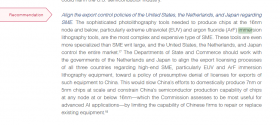some links on info I shared above for your reference:
I had assumed all 160K 300mm Wafwrs per month @ Beijing fab are capable of 28nm (previously website did not split that up the capacity numbers to 24-65nm & 55nm-0.18um). So using this new info but assume all 100k of 24-65nm can handle 28nm…plus 34K of 14nm from Shanghai, we are looking at only 135K 300mm wpm or 303K 200mm wpm….which would translate to roughly the 3.5M number you quoted, but in wafers per year.
then let’s multiply by 5…then we are looking at additional 675K 300mm wpm to be added.
SMIC already announced 235K 300mm wpm before 2025. So, I e can assume 440K more 300mm wpm could be added after 2025 (or 990K 200mm wpm).
that’s just a rough guesstimate based on known current capacity, capacity expansion, and on what Dr Zhao Haijun said. of course, to be accurate we have to look at the end application trend that would use 28nm from 2024 to 2035. But that would require more research.
anyhow, above is just my two cents.
New announced 28nm Shanghai fab:
New Beijing fab:
This one talked about the second 14nm and below fab in Shanghai:



